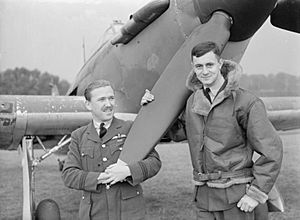Mark Henry Brown facts for kids
Quick facts for kids
Mark Henry Brown
|
|
|---|---|

Brown, on the left, and Pilot Officer Chetham of No. 1 Squadron standing by the nose of a Hawker Hurricane fighter at Wittering, England
|
|
| Nickname(s) | Hilly |
| Born | 9 October 1911 Portage la Prairie, Manitoba, Canada |
| Died | 12 November 1941 (aged 30) over Sicily, Fascist Italy |
| Buried |
Catania War Cemetery, Sicily
|
| Allegiance | United Kingdom |
| Service/ |
Royal Air Force |
| Years of service | 1936–1941 |
| Rank | Wing Commander |
| Service number | 37904 |
| Commands held | No. 1 Squadron |
| Battles/wars | World War II |
| Awards | Distinguished Flying Cross & Bar Czechoslovak War Cross |
Mark Henry Brown (October 9, 1911 – November 12, 1941) was a brave Canadian pilot. He became a flying ace during World War II. This means he shot down at least five enemy aircraft. He flew for the Royal Air Force (RAF). Brown was the first Canadian pilot to become an ace in the war. He sadly died in action over Sicily in November 1941.
Contents
Early Life and Joining the RAF
Mark Henry Brown was born in Portage la Prairie, Canada, on October 9, 1911. His friends called him 'Hilly'. After school, he worked at a bank in Brandon. He learned to fly planes at the Brandon Flying Club.
In May 1936, he moved to the United Kingdom. He joined the Royal Air Force as a pilot. After his training, he joined No. 1 Squadron in February 1937. At first, his squadron flew Hawker Fury biplanes. These were older planes with two sets of wings. Later in 1937, they got new, faster Hawker Hurricane fighters. In December 1938, he was promoted to Flying Officer.
World War II: Flying into Action
In September 1939, No. 1 Squadron went to France. They were part of the RAF Advanced Air Striking Force. They flew patrols near the French-German border. Sometimes, they fought against German planes, called the Luftwaffe.
On November 23, Brown helped shoot down a German Dornier 17 bomber. On March 3, 1940, he also helped shoot down a Heinkel He 111 bomber. The fighting became more intense in April. On April 20, Brown shot down a Messerschmitt Bf 109 fighter plane.
Battle of France: Becoming an Ace
On May 10, 1940, Germany invaded France. No. 1 Squadron was in constant battles. They had to move their airfields often. Brown helped destroy another Dornier 17 that day. The next day, he shot down two Messerschmitt Bf 110 heavy fighters.
On May 14, Brown shot down a Bf 109 and a Junkers Ju 87 dive bomber. With these victories, he became the first Canadian pilot to reach ace status. He kept fighting bravely. The next day, he shot down another Bf 110. On May 17, he destroyed another Bf 110 and a He 111.
He also destroyed a Henschel Hs 126 plane on May 18. On May 19, he shot down a He 111. He probably destroyed another one too. He destroyed another He 111 on May 21. On June 5, he destroyed a Dornier 17. His last victories in France were on June 14. He destroyed a He 111 and a Bf 109. The next day, his plane was shot down. But he landed safely and made his way back to England.
Battle of Britain: Defending England
After returning to England, No. 1 Squadron rested. They became ready for action again in late July. Brown was given the Distinguished Flying Cross (DFC). This award was for his "gallantry and devotion to duty."
On August 11, he shot down a Bf 110. On August 15, his plane was shot down again. He bailed out over the English Channel. He had only minor injuries and was rescued by a fishing boat.
On September 3, 1940, Brown was promoted to Flight Lieutenant. His squadron moved north for easier duties. But they still helped in the air battles over England. On September 6, Brown damaged a Junkers Ju 88 bomber. On September 24, he helped destroy a Dornier 17.
On November 10, the squadron's commander died. Brown took over as the new leader. He was promoted to Squadron Leader. The squadron stayed north until January 1941. Then they moved back south. They flew missions over France and escorted bombers. They also trained for night flying. Many of their pilots were from Czechoslovakia and Poland.
In April, Brown became an instructor. He taught new pilots at No. 58 Operational Training Unit. In May, he received a Bar to his DFC. This meant he got the award a second time. The award said he had destroyed at least 18 enemy aircraft. It praised his "splendid leadership." In July, Brown was promoted again to Wing Commander. He was put in charge of training at another unit.
Middle East: Final Mission
In October 1941, Wing Commander Brown went to the Mediterranean area. He was to lead the fighter planes on the island of Malta. On November 12, he flew his first mission as wing leader. He led an attack on an Italian airfield in Gela, Sicily.
During the attack, anti-aircraft guns hit Brown's Hurricane. His plane crashed at the airfield. Later, an Italian plane dropped a message over Malta. It said that Brown had been buried with full military honors.
Mark Henry Brown is buried in the Catania War Cemetery in Sicily. In January 1943, he received another award. He was given the Czechoslovak Military Cross. This was for his valuable help in the war.
Historians believe Brown shot down 15 German planes. He also helped destroy four more. He probably destroyed one and damaged two others.

